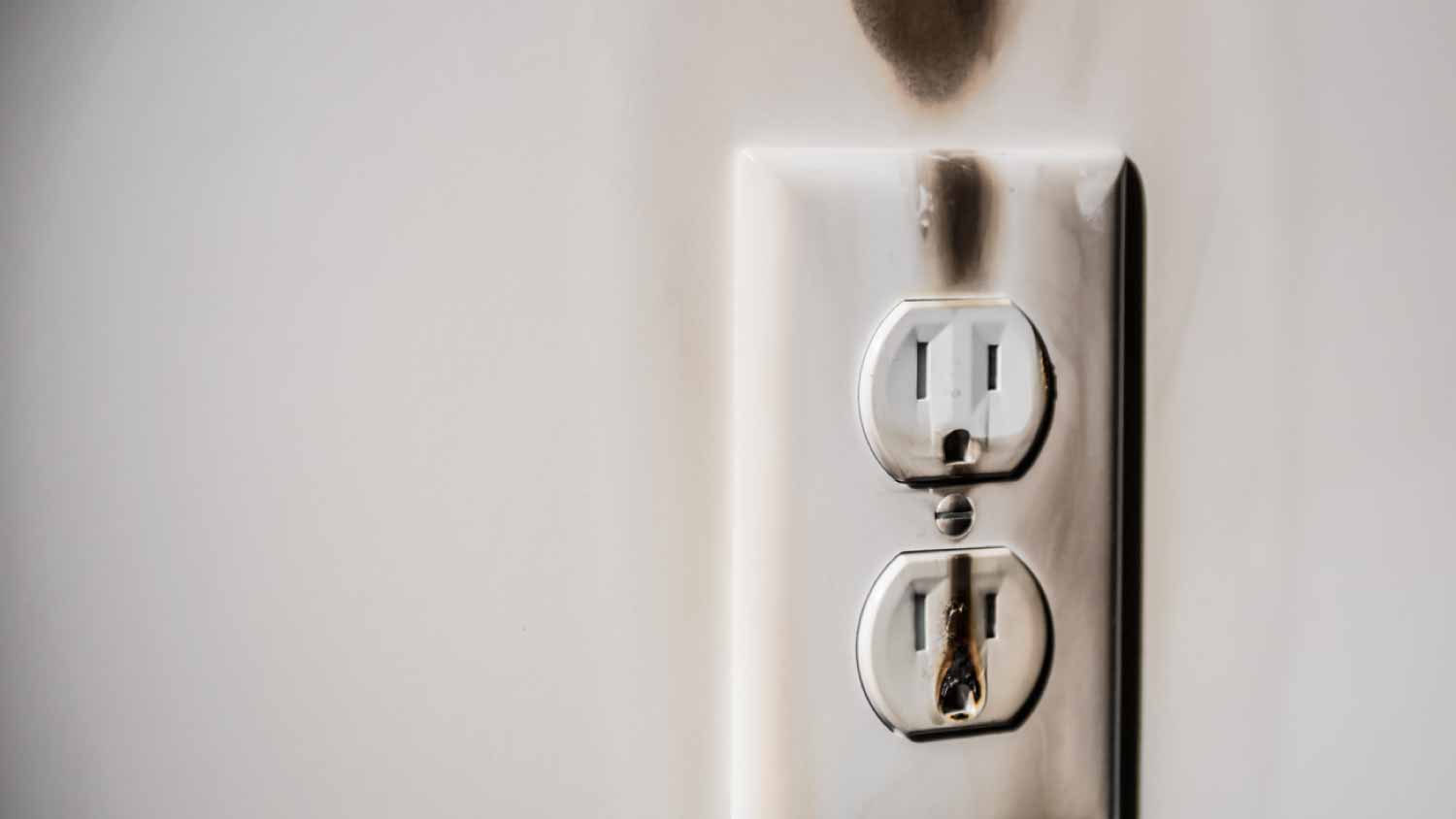5 Reasons Why Your Appliance Keeps Tripping Your Circuit Breaker
It's not the kind of trip you want to keep taking


Common causes of tripped breakers are an overloaded circuit, electrical short, ground fault, or overheated appliance.
There are several causes for each type of issue, so you’ll need professional help to troubleshoot.
Check your appliance’s warranty for repair or replacement coverage.
Let a licensed electrician handle any wiring or electrical problems.
You try to plug in the coffee maker or turn on a switch, and nothing works. Your circuit breaker has tripped for approximately the millionth time. If you know how to reset the circuit breaker, you can go through the motions. Or you can figure out what's causing the problem, so you don't have to run to the breaker panel every time you want a cup of joe.
Circuit breakers trip for multiple reasons, and you'll learn the common culprits here. Remember, for some solutions, it’s best to call a licensed electrician near you to make sure your home electrical system is operating safely.

1. The Circuit Might Be Overloaded
Circuit breakers in your house are critical safety mechanisms that keep wires from overheating. The circuit breaker trips when an individual circuit receives too much current and automatically shuts down to avoid the possibility of a fire.
Most kitchen, laundry, and bathroom appliances run on a lot of electrical power. The appliances in these rooms are likely on the same circuit, even if they're plugged into separate outlets, and could cause a circuit overload when running simultaneously. You may overload the circuit when running the pressure cooker, toaster, and oven at the same time.
How to Test for Circuit Overload
If one circuit breaker continues to trip, you may be using too much power in one section of your house. To test for circuit overload:
Turn off the breaker, and unplug all electrical devices and appliances in the area. Lamps, computers, and air conditioning units are just a few items you could be running on the same circuit.
Wait a few minutes, and switch the breaker back on.
Turn the devices on one by one, then wait a few seconds to see if the circuit breaker trips.
Did the breaker trip after turning on one of the electronic devices on the same circuit? If the answer is yes, then the circuit is overloaded.
A circuit breaker is usually a consistently warm temperature—but not hot. If the breaker box feels hot to the touch, seek professional help, or you could run the risk of an electrical fire.
Fixing an Overloaded Circuit
One simple solution is to adjust power usage in that one challenging area. For example, you may be able to move around some appliances, so they’re on a separate circuit.
However, this can be difficult depending on the spacing and setup of your appliances. If this is the case, you'll need to add circuits and possibly rewire your home. It can feel like a big project—and it’s definitely one that a local electrician should do. The cost to install a dedicated circuit is around $700. Rewiring portions of your home costs about $1,500 for simple projects and can go over $10,000 to rewire an entire house.
2. Result of a Short Circuit
When the required distance between wires isn’t maintained, loose wires can come into contact and cause a short circuit. A short circuit can cause a surge of electricity to flow through your electrical system, and your breaker will keep tripping.
What Causes a Short Circuit?
Wires can loosen over time, which is a problem for many homeowners. There are a few reasons for a short circuit:
Rodents chewing on your wiring
Deferred maintenance, or outdated wiring in an older home
Faulty or old wire insulation or nails or screws have pierced it through the wall
Loose wires within appliances, switches, or outlets
All of these causes can be challenging to detect and remedy without a professional's help.
How to Spot a Short Circuit
Repeat the previous test to check for a short circuit. This time, see if you're consistently tripping the breaker every time you plug a device into the same outlet. If so, you most likely have a short. Don’t use the outlet until it’s repaired, or you run the risk of getting an electrical shock, and make sure to keep the breaker in the off position instead of continually trying to reset it as this can also cause more problems.
3. Result of a Ground Fault
Electricity consists of negatively charged electrons that flow and are attracted to the ground because it is positively charged. This might occur in your house as a ground fault, in which electricity shifts from its intended route and travels into the earth instead.
What Causes a Ground Fault?
Ground faults can happen when a conductor like metal or water comes into contact with an exposed wire or the metal components of an outlet. Water from a leaking pipe, for example, could end up dripping into an outlet or switch box and cause the electricity to alter its path and continue into the ground.
Ground faults may be why your circuit breaker is tripping, and they’re common in older homes. The breaker will keep tripping even when you try to reset it. Thanks to modern wiring, newer ground wires allow electrical currents to reach the ground—but if moisture enters your outlets, appliances, or switches, you may still need professional help.
What to Do About a Ground Fault
If you believe a ground fault is causing your circuit to trip, it's time to call a local electrician. Don't tamper with any stray electrical currents without the necessary training or expertise. When ground faults occur due to faulty wiring, anyone repairing it risks coming into contact with live wires.
Electrical injuries can be life-threatening, so proceed with caution. Unless you're a licensed electrician, seek a pro to diagnose and safely repair your electrical system.
4. Circuit Breaker Might Be Failing
If your circuit breaker keeps tripping, it might be an indication that the circuit breaker box is failing or the breaker is undersized—meaning the circuit is improperly sized for the amount of current (amperage) passing through it.
How To Tell if You Have a Bad Circuit Breaker
Circuit breakers, like any other item in your house, can wear out. Warning indications of impending failure include:
A breaker that will not reset
A strong, burning odor coming from the panel
Breakers frequently trip
Scorch marks on a breaker and other signs of damage
Signs of home electrical problems like flickering lights or malfunctioning outlets
Bad circuit breakers are a common issue in older homes. If you haven’t had repairs on your electrical panel done for at least 10 years, you probably need to replace some of your circuit breakers.
5. Appliance May Be Malfunctioning

If your appliances or electrical system are not functioning correctly, take some time to consider your options. Any appliance can trip your breaker, but if it has faulty wiring, you should repair or replace the wiring in the appliance before using it again. A faulty appliance with broken wiring will short automatically and can trip numerous breakers.
Solutions for a Kitchen Breaker That Keeps Tripping
Your kitchen breaker is likely tripping due to an overloaded circuit, especially if you’re trying to make coffee, toast a bagel, and heat up a breakfast burrito all at once. Your small appliances add a large electrical load on top of what your refrigerator, dishwasher, or oven are already carrying. When you plug everything into the same circuit, it can become overloaded and cause the breaker to trip. Luckily, there are a few solutions that can remedy a kitchen breaker that frequently trips.
Add a Dedicated Circuit
A licensed electrician can add a dedicated circuit to your kitchen, such as one that runs your refrigerator or electric oven. The extra circuit allows high-powered appliances to run separately from your coffee maker and toaster oven. Your kitchen will have more power overall with another circuit in the mix, and you won’t need to add outlets unless you want to. An additional circuit can use existing outlets that route to a separate circuit breaker.
Move Your Appliances
If you have two circuits in your kitchen, distribute the power load by plugging your appliances into different spots. Plugging high-powered appliances into the same circuit can cause the kitchen breaker to trip. Instead, balance the load on your circuits. Run your coffee maker and toaster on one circuit, and your electric kettle and slow cooker on another.
You can determine which outlets are on the same circuit by turning off a breaker and seeing which outlets work and which don’t.
Run Appliances at Different Times
You may only have one circuit in your kitchen. Running too many appliances at once, such as your toaster, coffee maker, and electric kettle could overload the circuit. For a simple solution, use your appliances at different times to avoid tripping the breaker.
In older homes, sometimes your bathroom outlets are on the same circuit as some in your kitchen. So you might notice that when you use a hairdryer in the bathroom, it trips your kitchen breaker, because they are on the same circuit. You may have to use your bathroom appliances and kitchen appliances at different times.
How to Check Your Warranties
Check your user manual or call the manufacturer's customer service number to see what repair or replacement options are available. However, you'll need expert help if your house's electrical system fails.
Tyler Keezer, Home Energy Specialist and Expert Board Review member says, “As an electrical contractor, we deal with these types of issues every day, which can get serious if not looked after immediately. Having an experienced electrician evaluate and repair is always the best method if you’re experiencing any of these problems in this article.





- Home Generator Repair
- Lamp Repair
- Electric Repair
- Generator Installation
- TV Antenna Services
- Emergency Electricians
- Commercial Electricians
- Attic Fan Installation
- Attic Fan Repair
- Exhaust Fan Installation
- Electric Inspectors
- Subcontractors
- Electrical Construction
- EV Charger Installer
- Chandelier Installation
- Doorbell Installation
- Bathroom Fan Installation
- Ring Installers
- Electrical Panel Upgrade
- How to Tell if a Circuit Breaker Is Bad (and What to Do About It)
- Is It Dangerous If a Circuit Breaker Keeps Tripping?
- How to Replace a Circuit Breaker: A Complete Guide
- How to Fix a Short Circuit in Your Home
- How Does a Circuit Breaker Work?
- How to Tell If a Breaker Is Tripped: Everything You Need to Know
- Does Turning Off Breakers Save Electricity?
- Circuit Breaker vs. Surge Protector: What’s the Difference?
- 3 Reasons Why Your Light Switch Won’t Turn Off
- Why the Water Heater Keeps Tripping Breaker











